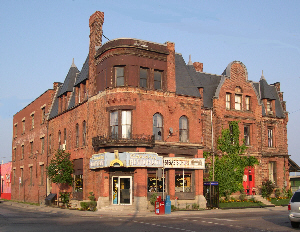Over time these adjoining buildings were also known as the Irvine House, Eastern Star Hotel, General Steel Ware warehouse, and the Canary Restaurant.
In the photo below, the three principal styles can be identified which reflect the periods of construction. On the right is the original Palace Street School, which was built in 1859. In the center, at the street corner, is the original hotel portion in the style of the 1890s. This is now the Canary Restaurant. To the east along Front Street at the back, is the warehouse space added in the 1920s or ’30s and later additions.

In March 1858, the population in the area was expanding rapidly. The Grand Trunk Railway had opened to Montreal 1856 and the gas works had greatly expanded in 1857. Gooderham Worts were planning a major expansion. Enoch Turner School had served the children of the St. Lawrence Ward for some time, but there was a general unease over its closeness to the church the fact that there were boys and girls together in one classroom. As a result, The Board of Education decided that it was time to erect a school house in this area. The Superintendent of the Public Schools for The City of Toronto, was able to report in his first Annual Report (for the year ending December 3l, 1859) that: “A Handsome brick School House has been erected on the corner of Palace and Cherry Streets in the Ward of St. Lawrence for the increased accommodations of residents in that part of the city. It consists of two school rooms, one for boys and the other for girls, each capable of receiving from 80-90 children. A master has been employed to take charge of the boys; and the former mistress of the (Enoch Turner) school retains charge of the girls. The new building is of so substantial a character that, should it in the course of time become necessary, the roof can be raised and an upper storey added so as to double the present accommodation.” Palace Street School was one of the earliest free schools in Toronto and is the only survivor of the early schools built by The Toronto Board of Education. It is one of the few surviving buildings in Toronto designed by Joseph Sheard, who eventually became Mayor. By the way, Palace Street was the original name for this portion of Front Street.
In 1893, the publication ‘Toronto, the Queen City of Canada” declared that: “A well known and popular hotel in this city is the Cherry Street Hotel, Mr. J.J.. Darcy, proprietor, situated at the comer of Cherry and Front Street. The building, a commodious brick structure, was originally a school house for a period of 45 years. In 1890 it was remodelled and rebuilt into a hotel and opened by Mr. Robert Irvine as the Irvine House. On the 20th of June, 1892, he was succeeded by Mr. Darcy, the present proprietor, who refitted and refurnished the house throughout and has since conducted it as the Cherry Street Hotel in a manner greatly redounding to his credit. The house contains upwards of 40 neatly furnished sleeping rooms, a well equipped dining room and office. The very best to be obtained in the market is served daily in the dining room, and in the well kept bar can always be found the choicest imported wines, liquors, ales, beer, porter, stout and cigars.”
Goad’s 1884 map shows that the area was then a residential neighbourhood, with a few industrial plants, including the Gooderham and Worts distillery and the Toronto Pork Packing Establishment. As time passed, the area changed to solidly to industrial uses and then became largely vacant. The building also changed first the school was closed and its structure incorporated into the Hotel as noted above. In time, the hotel failed and the building was left vacant from 1910 to 1922, when Thomas Davidson Manufacturing Company, Front Street, maker of enamel ware and Antipitzky Metal Company on Cherry Street took it over. General Steel Ware occupied and probably built the eastern warehouse addition. A number of tenants have come and gone over the years including Tippet Richardson. Further additions have been added to house a small furniture factory and warehouse. In 1965 it came alive again as the Canary Restaurant, a favourite of people working or living in the area. It provides studio apartments for several small industries and artists. A spy thriller was filmed on the site.
When the Palace Street School was built, schools were considered as “ornaments to the city.” In the history of our city, this structure has a appealing story to tell of an ever changing community. Congratulating its neighbour the Sackville School on its 90th anniversary, David Crombie, then Mayor, pronounced, “It is in its schools that the ethnic, cultural and economic changes in a neighbourhood are most perfectly reflected”. For some time it has been awaiting redevelopment; first as Ataratiri and now the West Don Lands. It may well shift away from the twentieth century industrial uses and back to its first use as a residential area. George Hodgins, an early Deputy Superintendent of Education for the Province, stated “everything around as well as within the school house should be attractive to the eye and improving to the taste of the earliest and most durable impressions.” This should be the philosophy governing the restoration and expansion of Palace Street School for the new community that will be established in the West Don Lands.
